Around the Neighborhood - Volume 2, Number 2
In 1973, Family Communications initiated a print newsletter titled Around the Neighborhood. This newspaper-like publication was largely directed towards parents but included some material for children as well. The information below documents the second issue from Volume 2 of Around the Neighborhood.
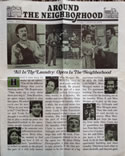
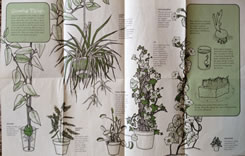
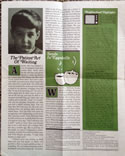
[click images for larger view]
Articles Included:
- All In The Laundry: Opera in the Neighborhood
- Growing Things
- The Patient Art of Waiting
- Seeds in Eggshells
- Neighborhood Highlights
Articles
ALL IN THE LAUNDRY: OPERA IN THE NEIGHBORHOOD
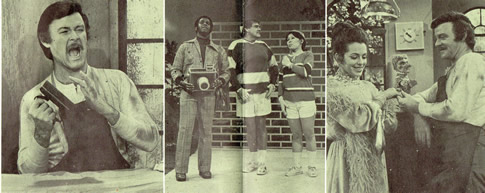
Here's one way to make up an opera: "Use all the different things that you're thinking about," Mr. Rogers says. "Then make up a story about them and sing it." John Reardon, an opera singer, helped the plan this opera. he asked each one he met, "What do you want to be?" Chef Brockett and Yoshi Ito thought it would be fun to play a made-up game like Handball-Football in the opera. Other people wanted to pretend to be someone very different from themselves. Betty Aberlin wanted to find out how it felt to have "quadrillions" of dollars to spend, so she played the part of a rich lady named Miss Morgan. Mr. Reardon likes to work hard with his hands. He played the part of a man called Gillespie who works in a laundry. He washes and irons the dirty things people bring to the laundry. After a while, the soap and water that looks so messy gets everything clean. Lady Elaine Fairchilde really wanted to play a mean old woman. She took the part of Alice Claire, the owner of the laundry. Alice Claire is mean to Gillespie and never helps him with the work. Francois Clemmons wanted to be in the opera too. He plays Philip Photographer, a man who likes to take pictures. X the Owl pretends to be the owner of a big apartment building . In ALL IN THE LAUNDRY, Miss Morgan wants to buy X's apartment building. The sheets and towels for the building are at the laundry. When X and Miss Morgan go to pick up the laundry, Gillespie and Miss Morgan meet. They like each other and decide to marry. Miss Morgan buys the laundry from mean Alice Claire for 23 quadrillion dollars. Now they don't have a lot of money, but she and Gillespie have a lot of work to do in their new apartment building and their laundry. They have each other to share the work, and they are glad.
A seed is planted in the earth. It needs water and warm sunlight to start to grow. Soon the seed can send a small green sprout up through the earth. Each new leaf unfolds so slowly that it's hard to see that it's growing. But in time a seed will grow into the kind of plant it is meant to be. Here are some of the many different ways plants can grow.
Avocado: From a pit the size of a lemon, the avocado can grow as tall as a small tree.
Sensitive Plant: Most people don't know that plants can move, but the leaves of the sensitive plant can. They fold down tight if you touch them.
Spider Plant: Baby plants grow at the ends of the long stalks of the Chlorophytum elatum, or spider plant. Chlorophytum elatum is the second favorite plant which Harriet Elizabeth Cow gave to King Friday.
Venus Flytrap: The Venus flytrap also has leaves that move. If a fly crawls on to a leaf and touches one of the little spines inside it, the leave will close. The flytrap catches bugs and flies this way.
Morning Glory: The morning glory vine has flowers shaped like bells or trumpets. The flowers close tightly at night and open again each morning.
Ivy: An ivy plant has many strong little vines called tendrils growing from its stems. The tendrils reach out and wrap themselves around chinks in wood or stone. They can hold the plant up as it climbs.
Shamrock: The plant is called a shamrock. It always stays small, even when it is fully grown.
- - - - - - - - - - - -
Put a narcissus or crocus bulb on some wet pebbles in a bowl or saucer. The bulb will grow tall green stems, and flowers will blossom.
Roll a piece of paper towel into a clear glass. Put a kernel of corn or a lima bean between the paper and the side of the glass. Keep it moist. You can watch the seed send roots down and sprouts up.
Sprinkle grass seed or bird seed on a wet sponge. Keep the sponge wet, and in about a week, the seeds will sprout.
Anyone who has planted a row of marigold seeds and waited three whole days for the first tiny pale-green shoots to come up knows how much time little things can take. And if you waited those three days with a curious child, you know how much longer the time takes for a small child. The child who helped you plant the seeds and water them is back in ten minutes, scraping away the dirt "to see if it's growing yet." As you explain again how it takes time to grow a sprout we can see, you may be able to remember yourself long ago when time was endless and words like "week" or "month" still had no meaning. Empathy can help you feel a child's waiting time. You can help him fill it the way you fill your own waiting times, by putting other activities inside them. You can help even more by recognizing and commenting on the invisible "growing inside" each child does little by little as he grows. A small child who asks you almost every day, "Am I still three and a half?" needs to know that even though she or he is still small, she is bigger than she was a month ago. She is growing on the inside, in control, cooperation, understanding. A child who understood this once told Fred Rogers proudly, "I only wear diapers at night now."
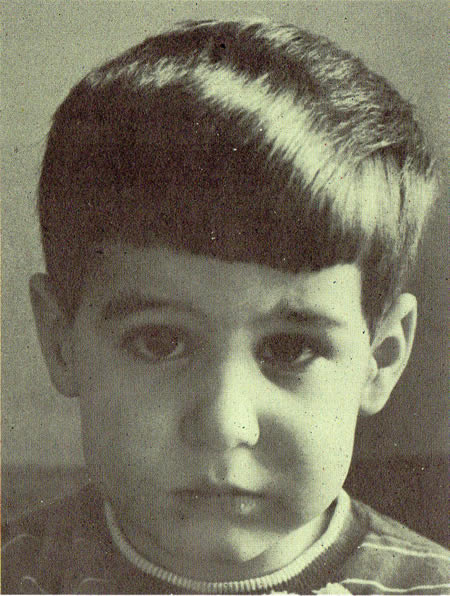
Children grow very slowly, in small steps and jogs and spurts. A child's real growth is often as imperceptible as that of a seedling. We can't help asking that toilets be flushed and jackets hung up -- we notice what is out of place. One day a jacket is hung on its hook and we think, "It's about time you learned." And yet remembering not to run across a new lawn or controlling the urge to hit are genuine accomplishments worthy of notice. Praise for the small real triumphs shows that parents do see a child growing, getting bigger. We can quickly pick up the habit of praising a child in specific words that match his actions; for example, "You did put the spoons away in the right place, every one of them." Words vary, but each parent will find the special words that come naturally to him and her.
It must be easier to "wait until you're bigger" if you can see that time is not an empty space stretching out endlessly, but is filled with your own actual growings.
When Mrs. McFeely breaks eggs for cooking, she saves the shells to plant seeds in. Each eggshell half can hold enough dirt to plant some of the seeds you can find each day. You can save tomato seeds from your salad. If you eat a melon sometimes you can save a few of the seeds you spit out. Apples, oranges, watermelons, and grapefruits have seeds you can dry for two weeks and then plant. You can set the eggshells in half an egg carton. if you plant different seeds in each pocket, you can see how differently they grow. When the seedlings grow too tall and big to stay in the eggshells, crack the shells gently by squeezing them in your hand. Put the eggshell plant into a garden.
Note: If you miss a program that you or your child is particularly interested in, check with your local station to see when it will be repeated. Give them the program number.
Week of April 29
X the Owl makes a xylophone (#506) and Daniel contributes four small building blocks for the highest notes. Lady Elaine Fairchilde pretends that the baseball bat Corny gives her is an "engagement bat" (#507). She compounds her deliberate mistake by announcing her wedding and making plans. In Mr. Rogers' Neighborhood, Elsie Neal talks with a weaver (#509) and Chrissie Thompson visits her grandparents, the McFeelys (#510).
Week of May 6
Mr. McFeely surprises Mrs. McFeely with a player piano. In Make-Believe, Corny finds out about the wedding plans and politely declines to be the groom (#512). Lady Elaine is disappointed, but goes anyway to the party the neighborhood has instead of a wedding (#513). Professor Larson shows Fred Rogers his collection of rare instruments (#513). Fred Rogers brings a suitcase full of puppets (#514) to show how they work, and Lady Elaine turns her Museum-Go-Round into a TV station. King Friday demands that she get a license for it (#515).
Reruns begin:
Week of May 13
Chrissy Thompson and her big sister Terri come to spend the week with the McFeelys. They construct a puppet theatre out of a large cardboard carton. On Friday, they surprise the McFeelys with a fairytale puppet show they have made up all by themselves. Fred Rogers shows a film about a kindergarten visit. He and Chrissy have some quiet time to talk about what it's like to need leg braces to help you walk well.
Week of May 20
Mary Sweeney and Betty Aberlin practice dancing like a bird (#326). King Friday invites X to read his poetry and other neighbors find they have poems in them too (#327). A juggler practices in the rehearsal room (#328). Chef Brockett shows many kinds of breads (#329) and in Make-Believe, a huge flying bread brings X a message from the Owl Correspondence School.
Week of May 27
(#331) Cheerleaders visit Mr. Rogers and Jamie Rogers and some friends demonstrate tether balls and yoyos. Robert Troll learns to let go of the ball and trust that his friends will toss it back to him. Mrs. McFeely feeds a lamb with a baby bottle (#332). Mr. Rogers shows how to make a clothespin paddle wheel boat (#334). In Make-Believe, Corny dumps a factory wood stain into the stream and the neighborhood learns about water pollution.
Credits
Around the Neighborhood and the materials that accompany it are published ten times a year by Family Communications, Inc., a not-for-profit Pennsylvania corporation. Mister Rogers' Neighborhood is funded by public television stations, the Ford Foundation, the Corporation for Public Broadcasting, Sears Roebuck Foundation, and Johnson & Johnson Baby Products Company.
Around the Neighborhood is created in association with Media Projects Incorporated of New York. Subscriptions, printing, and distribution are accomplished by Multiscope, Inc., Pittsburgh, Pa.
Executive Editor: Sara Stein
Editor: Barbara Staib
Editorial Consultant: Hedda Sharapan
Psychological Consultant: Dr. Margaret McFarland
Graphic Designer: Tobias O'Mara
© 1974, Family Communications Inc.
